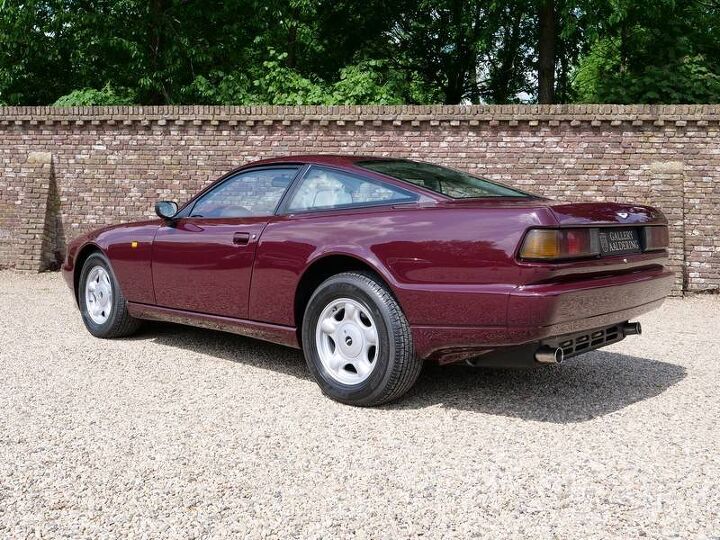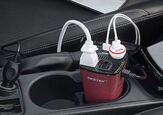Rare Rides: The 1990 Aston Martin Virage - End of Aston Independence

The Rare Rides series featured a vintage Aston Martin once before, when we took a look at the luxurious Lagonda sedan from 1984. Today we move forward in history a few years to see a luxurious, large coupe that’s more along the lines of what you’d expect from the Aston Martin brand.
It’s a Virage, from 1990.
The Virage occupied an interesting time in the history of Aston Martin with regard to both ownership and product offerings. Throughout the 1980s, the company continued producing the same vehicles it made since the middle Seventies. The aforementioned Lagonda debuted in 1974, and the V8 coupe (regular and DBS) had been available since 1969. The only other mainstream model the company offered was the V8 Vantage, which was new for 1977.
As the 1980s drew to a close, Aston Martin prepared a single new car to hold the banner for the brand. That car was the V8 Virage. Introduced for 1989, the Virage would end up the last model developed while Aston Martin was still under the ownership of Victor Gauntlett. Gauntlett was a wealthy petroleum executive who revived the Aston Martin brand in the early Eighties. Before that, Aston suffered through three different owners between 1970 and 1979.
When it debuted at the Birmingham Motor Show in 1988, Aston Martin pitched the Virage as its new flagship. More than that, it would be its everything for the first few years of production. From 1989 to 1992 the Virage was the only Aston Martin offering, joined by the higher performance (and identical looking) V8 Vantage in 1993, and the Ford-funded DB7 in 1994. By that time the company came under Ford’s corporate umbrella. The DB7 was in the works under Gauntlett’s ownership, but the cash required to develop an all-new model was more than he wanted to bear. Ford purchased a small stake in Aston in 1987, and Gauntlett stayed on as the chairman through 1991. That year, with DB7 development heating up, Ford took a controlling stake in Aston Martin. Gauntlett stepped aside for Walter Hayes, VP for Ford of Europe.
As one might imagine, the development of the Virage occurred on a bit of a budget. The chassis was a variant of the old Lagonda’s design. Keen eyes will recognize the tail lamps from a Volkswagen Scirocco and switches from European Fords. Powered by an aluminum 5.3-liter V8, 330 horsepower propelled the 3,946-pound coupe to 158 miles an hour. Finding 60 in 6.5 seconds even with an automatic transmission, it was a very quick car for the time. A five-speed manual was optional, and was selected about 40 percent of the time. The automatic in Virage examples before 1994 (like here) was the ever-popular three-speed TorqueFlite from Chrysler. Living on through 1995 (365 produced), the original Virage morphed slightly into the V8 Coupe that ran through 2000.
Today’s Rare Ride is located in the Netherlands, and asks about $96,700. Generally, for examples located in North America with low miles, asking prices are between $75,000 and $90,000.
[Images: seller]

Interested in lots of cars and their various historical contexts. Started writing articles for TTAC in late 2016, when my first posts were QOTDs. From there I started a few new series like Rare Rides, Buy/Drive/Burn, Abandoned History, and most recently Rare Rides Icons. Operating from a home base in Cincinnati, Ohio, a relative auto journalist dead zone. Many of my articles are prompted by something I'll see on social media that sparks my interest and causes me to research. Finding articles and information from the early days of the internet and beyond that covers the little details lost to time: trim packages, color and wheel choices, interior fabrics. Beyond those, I'm fascinated by automotive industry experiments, both failures and successes. Lately I've taken an interest in AI, and generating "what if" type images for car models long dead. Reincarnating a modern Toyota Paseo, Lincoln Mark IX, or Isuzu Trooper through a text prompt is fun. Fun to post them on Twitter too, and watch people overreact. To that end, the social media I use most is Twitter, @CoreyLewis86. I also contribute pieces for Forbes Wheels and Forbes Home.
More by Corey Lewis
Latest Car Reviews
Read moreLatest Product Reviews
Read moreRecent Comments
- SCE to AUX How well does the rear camera work in the rain and snow?
- MaintenanceCosts The Truth About Isuzu Troopers!
- Jalop1991 MC's silence in this thread is absolutely deafening.
- MaintenanceCosts Spent some time last summer with a slightly older Expedition Max with about 100k miles on the clock, borrowed from a friend for a Colorado mountain trip.It worked pretty well on the trip we used it for. The EcoBoost in this fairly high state of tune has a freight train feeling and just keeps pulling even way up at 12k ft. There is unending space inside; at one point we had six adults, two children, and several people's worth of luggage inside, with room left over. It was comfortable to ride in and well-equipped.But it is huge. My wife refused to drive it because she couldn't get comfortable with the size. I used to be a professional bus driver and it reminded me quite a bit of driving a bus. It was longer than quite a few parking spots. Fortunately, the trip didn't involve anything more urban than Denver suburbs, so the size didn't cause any real problems, but it reminded me that I don't really want such a behemoth as a daily driver.
- Jalop1991 It seems to me this opens GM to start substituting parts and making changes without telling anyone, AND without breaking any agreements with Allison. Or does no one remember Ignitionswitchgate?At the core of the problem is a part in the vehicle's ignition switch that is 1.6 millimeters less "springy" than it should be. Because this part produces weaker tension, ignition keys in the cars may turn off the engine if shaken just the right way...2001: GM detects the defect during pre-production testing of the Saturn Ion.2003: A service technician closes an inquiry into a stalling Saturn Ion after changing the key ring and noticing the problem was fixed.2004: GM recognizes the defect again as the Chevrolet Cobalt replaces the Cavalier.fast forward through the denials, driver deaths, and government bailouts2012: GM identifies four crashes and four corresponding fatalities (all involving 2004 Saturn Ions) along with six other injuries from four other crashes attributable to the defect.Sept. 4, 2012: GM reports August 2012 sales were up 10 percent from the previous year, with Chevrolet passenger car sales up 25 percent.June 2013: A deposition by a Cobalt program engineer says the company made a "business decision not to fix this problem," raising questions of whether GM consciously decided to launch the Cobalt despite knowing of a defect.Dec. 9, 2013: Treasury Secretary Jacob Lew announces the government had sold the last of what was previously a 60 percent stake in GM, ending the bailout. The bailout had cost taxpayers $10 billion on a $49.5 billion investment.End of 2013: GM determines that the faulty ignition switch is to blame for at least 31 crashes and 13 deaths.It took over 10 years for GM to admit fault.And all because an engineer decided to trim a pin by tenths of a millimeter, without testing and without getting anyone else's approval.Fast forward to 2026, and the Allison name is no longer affiliated with the transmissions. You do the math.







































Comments
Join the conversation
The back of this thing looks like it was lifted with a taffy puller.
Minor correction; the tail-lights are from the VW Scirocco. The headlamps are from the Audi 200.